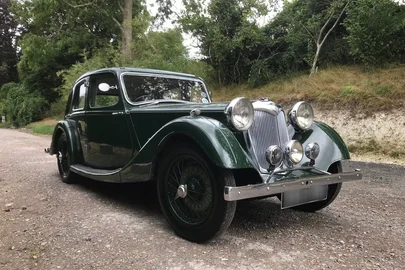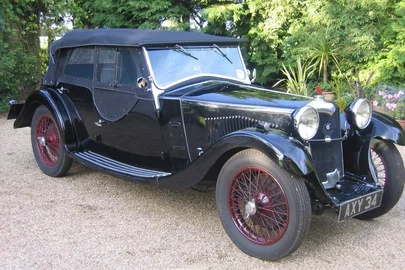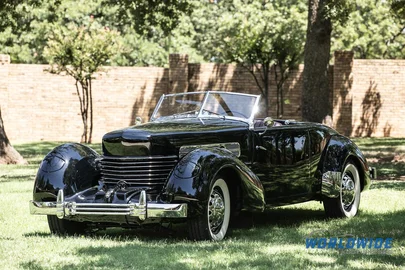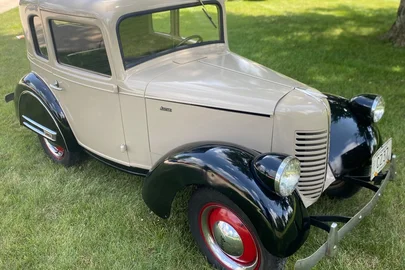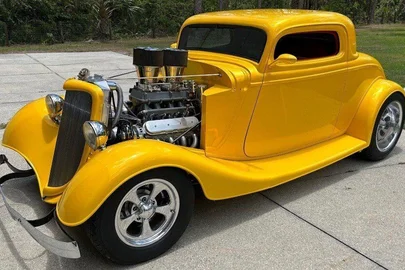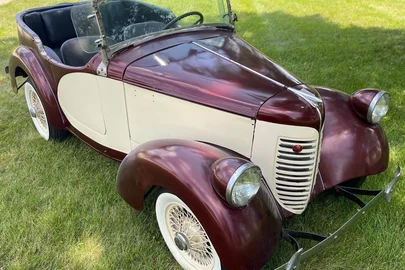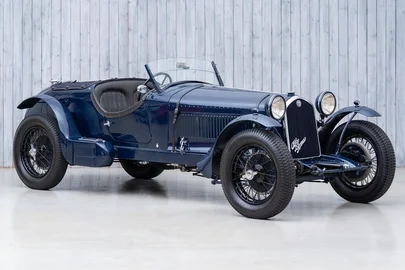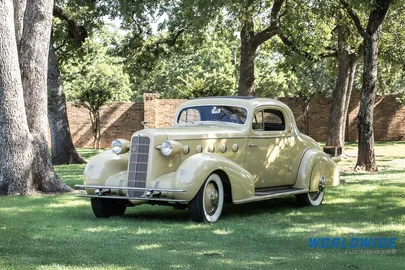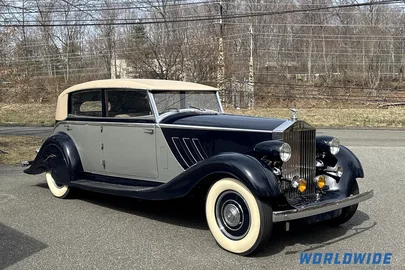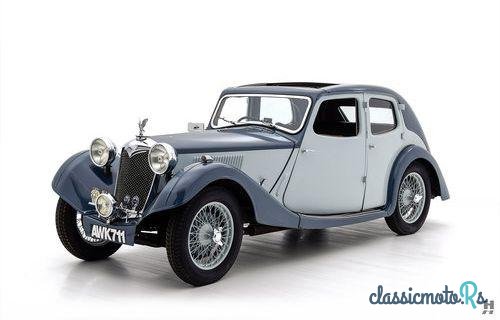
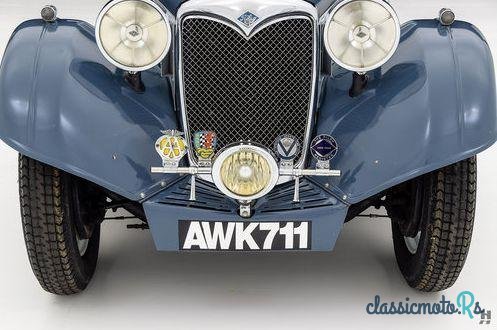
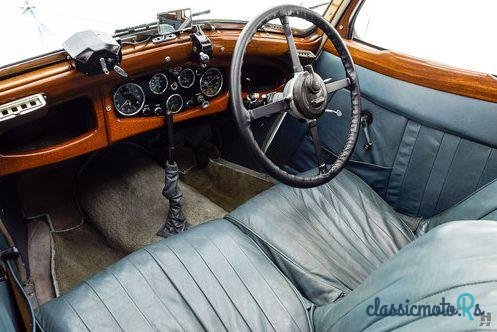
3 photos
1935' Riley Kestrel Saloon
Signaler cette annonce!Évaluer!Ajouter aux favoris
NégociablePublié 24 Avril 2019ID: ZcbD85
Périmée
il y a 6 années, 8 mois
il y a 6 années, 8 mois
Information from the owner
Corps: Coupés Sportives
Âge: 84 années
Couleur de la carrosserie: Bleu
Extérieur: Feux de brouillard
Commentaires du vendeur sur 1935' Riley Kestrel Saloon
Riley Motors was once one of the most respected English sporting marques, located in the heart of the British motor industry in Coventry. Like many pioneering automobile companies around the world, Riley got their start in the bicycle business before trying their hands at motorized transport in 1898. Their first efforts amounted to small-displacement cycle cars utilizing engines outsourced from De Dion Bouton or Motor Manufacturing Co (MMC). By 1903, Riley began making their own engines, and the vehicles steadily grew in size and output. Riley motorcars were highly regarded for their quality, and W.O. Bentley was counted among owners of the 9 h.p. model. Concurrent with car production, Riley manufactured their own wire spoke wheels which they had perfected during their time building bicycles. Such was the quality of their wheels that they began building them under contract for other manufacturers, including Rolls-Royce, Panhard, Mercedes and Hispano-Suiza among other prestigious firms. The operation was so successful that wheel building threatened to drown out Riley’s car business altogether! To keep things afloat, a separate company was established to handle the wheels, thus allowing automobile production to carry on without distractions.
1926 saw the introduction of Percy Riley’s 1,087 cc nine horsepower four-cylinder engine. It was an ingenious design, with twin gear-driven camshafts and hemispherical, cross-flow combustion chambers. The engine looked for all intents like an overhead cam unit; however, the cams were mounted high in the block, operating pushrods and rockers for the 90-degree incline valves. The engine became a hallmark of Riley cars, with various evolutions of the design powering Riley models through 1957, and tuned versions motivating Donald Healey’s rapid and highly successful sports cars of the 1940s.
By 1935, the original Percy Riley engine design was reworked by Hugh Rose and enlarged to 1 ½ litres. This new Riley was aptly named the 1 ½ Litre and offered in a variety of saloon, coupe, tourer and sports bodies. Riley chose evocative names for each body style such as Lynx, Ascot, Brooklands, and Stelvio. Despite its moderate capacity, the Riley 1 ½ litre was a highly capable and well-equipped sporting car. It had exceptional performance, and such exotic features as a preselect gearbox (sourced from Armstrong-Siddeley) and a Bijur chassis oiling system. Rileys of the day were sophisticated performance cars built to a very high standard of quality. The 1 ½ Litre became a fixture of the marque and remained quite popular with buyers until 1938 when Lord Nuffield of Morris Motors took a controlling stake in Riley and costs were reined-in.
Arguably the prettiest of all Riley 1 ½ Litre saloons was the Kestrel, as featured here with this 1935 example. The Kestrel is a lovely illustration of early English streamline design, with beautiful flowing wings and a gracefully sweeping line from the windscreen to tail. It sits low, with a distinctly sporting appearance thanks to the canted-back radiator and the “fastback” roof design. This lovely Kestrel wears a matured older restoration, enjoyed as a rally car for many years by its enthusiastic prior owner. These are wonderful driver’s cars, as this example proved by completing the very first Colorado Grand rally in 1989. It has a pleasing patina while remaining in generally sound and attractive condition. The two-tone blue paintwork highlights the features and flowing lines of the original coachwork. The finish is in fair condition, showing some minor checking in places, but remaining glossy and attractive. The quality of the coachwork is a testament to the high standard to which these cars were built. All four doors open and shut with a solid click, and all of the panels, including the sliding sunroof, fit very well. Brightwork is minimal, used only to highlight the inherently pretty shape. The radiator grille, with its mesh insert, is flanked by Rotax headlamps and a Notek fog lamp mounts centrally on the front apron. Plating is generally good and consistent with the age and character of the restoration, though some peeling is noted on the radiator shell.
Complimentary blue leather adorns the four-place cabin, which has a moderate patina that is consistent with the rest of this car. The leather is in a fair state all around, with plenty of inviting character acquired through years of enjoyment. Light blue carpeting has faded but is good, serviceable and intact. Extensive interior woodwork features on the dash and window surrounds, all presented in excellent condition. Instruments are a mix of period-appropriate Jaeger, Smiths, and Riley-branded pieces.
The highly-advanced 1 ½ litre four-cylinder engine presents in generally tidy condition and produces surprising power considering its modest capacity. While serving as a rally and tour car, some modern clamps, fittings, and hardware were used to facilitate easier on-the-go service. It runs well, although some additional sorting is recommended before embarking on any long journeys. The chassis and suspension components are in similar condition, showing some use but appearing in good condition.
This lovely Riley Kestrel saloon is one of just a handful of survivors. Rare and exquisitely engineered, this motorcar presents a unique alternative to similar capacity sports cars from MG or Alvis. The honest and charming presentation combines with the powerful engine, fine handling, and lightweight coachwork to make this Riley 1 ½-Lire ideally suited for preparation for driving events and rallies.
$59,500
STOCK NUMBER 6231
1926 saw the introduction of Percy Riley’s 1,087 cc nine horsepower four-cylinder engine. It was an ingenious design, with twin gear-driven camshafts and hemispherical, cross-flow combustion chambers. The engine looked for all intents like an overhead cam unit; however, the cams were mounted high in the block, operating pushrods and rockers for the 90-degree incline valves. The engine became a hallmark of Riley cars, with various evolutions of the design powering Riley models through 1957, and tuned versions motivating Donald Healey’s rapid and highly successful sports cars of the 1940s.
By 1935, the original Percy Riley engine design was reworked by Hugh Rose and enlarged to 1 ½ litres. This new Riley was aptly named the 1 ½ Litre and offered in a variety of saloon, coupe, tourer and sports bodies. Riley chose evocative names for each body style such as Lynx, Ascot, Brooklands, and Stelvio. Despite its moderate capacity, the Riley 1 ½ litre was a highly capable and well-equipped sporting car. It had exceptional performance, and such exotic features as a preselect gearbox (sourced from Armstrong-Siddeley) and a Bijur chassis oiling system. Rileys of the day were sophisticated performance cars built to a very high standard of quality. The 1 ½ Litre became a fixture of the marque and remained quite popular with buyers until 1938 when Lord Nuffield of Morris Motors took a controlling stake in Riley and costs were reined-in.
Arguably the prettiest of all Riley 1 ½ Litre saloons was the Kestrel, as featured here with this 1935 example. The Kestrel is a lovely illustration of early English streamline design, with beautiful flowing wings and a gracefully sweeping line from the windscreen to tail. It sits low, with a distinctly sporting appearance thanks to the canted-back radiator and the “fastback” roof design. This lovely Kestrel wears a matured older restoration, enjoyed as a rally car for many years by its enthusiastic prior owner. These are wonderful driver’s cars, as this example proved by completing the very first Colorado Grand rally in 1989. It has a pleasing patina while remaining in generally sound and attractive condition. The two-tone blue paintwork highlights the features and flowing lines of the original coachwork. The finish is in fair condition, showing some minor checking in places, but remaining glossy and attractive. The quality of the coachwork is a testament to the high standard to which these cars were built. All four doors open and shut with a solid click, and all of the panels, including the sliding sunroof, fit very well. Brightwork is minimal, used only to highlight the inherently pretty shape. The radiator grille, with its mesh insert, is flanked by Rotax headlamps and a Notek fog lamp mounts centrally on the front apron. Plating is generally good and consistent with the age and character of the restoration, though some peeling is noted on the radiator shell.
Complimentary blue leather adorns the four-place cabin, which has a moderate patina that is consistent with the rest of this car. The leather is in a fair state all around, with plenty of inviting character acquired through years of enjoyment. Light blue carpeting has faded but is good, serviceable and intact. Extensive interior woodwork features on the dash and window surrounds, all presented in excellent condition. Instruments are a mix of period-appropriate Jaeger, Smiths, and Riley-branded pieces.
The highly-advanced 1 ½ litre four-cylinder engine presents in generally tidy condition and produces surprising power considering its modest capacity. While serving as a rally and tour car, some modern clamps, fittings, and hardware were used to facilitate easier on-the-go service. It runs well, although some additional sorting is recommended before embarking on any long journeys. The chassis and suspension components are in similar condition, showing some use but appearing in good condition.
This lovely Riley Kestrel saloon is one of just a handful of survivors. Rare and exquisitely engineered, this motorcar presents a unique alternative to similar capacity sports cars from MG or Alvis. The honest and charming presentation combines with the powerful engine, fine handling, and lightweight coachwork to make this Riley 1 ½-Lire ideally suited for preparation for driving events and rallies.
$59,500
STOCK NUMBER 6231
